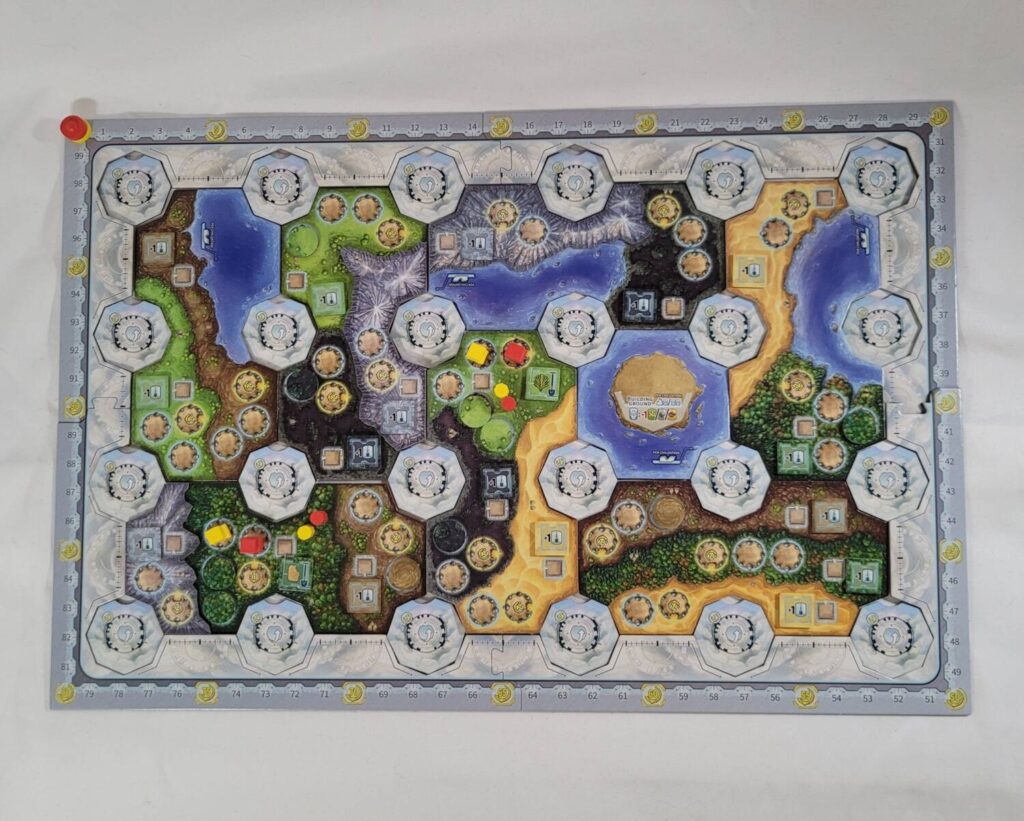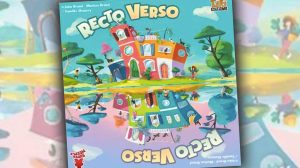Hello and welcome to ‘Focused on Feld’. In my Focused on Feld series of reviews, I am working my way through Stefan Feld’s entire catalogue. Over the years, I have hunted down and collected every title he has ever put out. Needless to say, I’m a fan of his work. I’m such a fan, in fact, that when I noticed there were no active Stefan Feld fan groups on Facebook, I created one of my own.
Today we’re going to talk about 2024’s Civolution, his 41st game. This game marks a couple of firsts for Stefan Feld. For one, it’s his first ever collaboration with publisher Deep Print Games. Secondly, Civolution is Stefan Feld’s first foray into the realm of classic science fiction (unless you’re counting 2014’s Aquasphere, in which case it’s his second). Regardless, as you’ll soon see, there’s no arguing that Civolution is his heaviest game to date.
Overview
In Civolution, players take on the roles of deities that are taking the final exam in their Civilization Building 101 class. The exam is being proctored by a highly-developed AI called Agera. Over the course of the game, players will be tasked with things such as exploring the map set before them (populating it and exploiting it for its resources) and developing their civilization to gain access to more powerful actions and specialized traits.
Civolution is an action selection game played with dice. On a player’s turn, they’re going to select two of their dice and pair them up to take one of the game’s many different actions. When they get low on dice, or their dice pool runs out, they’ll have to reset. These resets function as the game’s timer. After a certain number of them have been performed, the current era will come to an end and an interim scoring will be performed. Then, the next era begins. After four eras and the final scoring, the person who’s managed to score the most points will win the game.
As you will soon discover, this is a massive oversimplification of how the game is played. If you’d like to learn more about that, then read on. Otherwise, feel free to skip ahead to the Thoughts section to see what I think.
Exam Prep
Civolution is a massive, sprawling game with a whole lot of rules overhead. I’m going to do my best to keep things brief while, hopefully, giving you a good sense of how everything works and how things mesh together. So, let’s begin with setup.
There are four main components in Civolution: the Progress board, the Sequence board, the Map, and the player board (“Console” in the game’s vernacular). To set up the game, you’ll first assemble the map frame and then construct your map using the Continent tiles. These tiles can be rotated any which way you like to fit within the frame. There’s a great degree of customization available, but the rulebook provides a suggested setup for your first few games. Once the map is assembled within the frame, there will be holes where the corners of the various pieces come together. These holes are filled with face-down Site tiles.

There are six different types of terrain in the game—forest, grassland, swamp, mountains, hills, and desert—and each of these has three different resource types associated with it. Forests, for instance, can produce wood, wax, or oil. There is a Material tile for each resource. For each terrain, a Material tile matching the terrain’s type is placed, face-down, onto the space provided. Two of these Material tiles will be turned face-up (marked by the word “Start” printed on the terrain).
Next, place the Progress board and Sequence boards nearby. The Sequence board is where the Event card deck lives as well as the Phase Indicator marker, four randomly selected Scoring tiles (from a total pool of nine), and the Weather marker. The Progress board is seeded with a number of Goal, Income, and Attribute chips; some extra pink and white dice; some 100+ score markers; the hunting markers; as well as all but two of the remaining Scoring tiles. The unused Scoring tiles are returned to the box. For the sake of clarity, I will refer to the Map, the Progress board, and the Sequence board collectively as the “main board”.
Then come the card decks, of which there are five. Each deck is shuffled and placed face down next to the main board with room for a discard pile.

Each player’s Console is seeded with the various buildings of each player’s selected color, six dice (each set to a different face and placed into their respective starting positions), and all of the player’s Module tiles turned to their Level 1 sides. Each player’s round discs are set onto the main board at the start of each progress track, the start of the Favor of Agera track, and the 0 space of the score track. Each player also begins with one worker placed onto an encampment space of both of the Start terrains and a resource cylinder placed onto each of these terrains as well. Then a start player is selected and given the Starting Monolith standee.
What happens next is dependent on which mode of setup you choose to follow. There’s a suggested setup with some specially marked starter cards for your first few games. Once you’ve gotten used to the way things work, though, you’ll probably want to start doing the following:
Each player is given two cards from each of the decks along with two Starting Marker cards. Then, they select one of each to keep as their starting hand, discarding the others. The Starting Marker card determines which resources and features a player begins the game with along with how many Idea, Money, Food, and Focus markers. Once players have selected these, a number of Starting Chips cards are drawn and seeded with one Bonus chip each. Players will draft these in reverse turn order. These determine which Module each player begins the game with already flipped to its second tier, which Bonus chip they start with, and it will also function as their very first Income chip. Then you’re ready to begin playing.
Your Console
I realize there was a lot of terminology I just glossed right over during the setup. So, let’s address some of it right now. Let’s talk about your Console.
The left side of your Console is primarily a storage area for the resources, gold, and food you’ve obtained. Some of these areas have images of diamonds attached to them. Fulfilling the conditions to be awarded a diamond will earn you points at the end of the game. For instance, the food and coin spaces award you a diamond for every completed column of resource cylinders you have in the locations at the end of the game. Other spaces earn diamonds in different ways. In total, there are forty-three diamonds that a player can earn.
The right side of the Console is where the magic happens. This is where all of your dice and Module tiles reside. On your turn, you’ll be using two of your available dice and assigning them to a module in order to carry out one of its associated actions. These Modules can be upgraded through various actions or rewards in the game (completing a Bonus chip, for instance). If moving from a Level 1 to a Level 2 Module, the Module tile is flipped to its opposite side. If moving from Level 2 to Level 3, the tile is removed from the board entirely, revealing its fully upgraded form. And, as you can guess, the more advanced a Module is, the better the action(s) it provides.

Each Module requires a specific combination of dice in order to be activated. For instance, the Sustenance Module (which allows you to go hunting for food) requires a die with two pips and a die with four pips to activate. But, what if you don’t have a two and a four? Well, lucky for you, Civolution provides a whole heaping mound of dice mitigation.
Dice mitigation comes in one of three flavors: ideas, focus, and planning. Ideas can be spent to adjust any die value +/- 1 (with ones rolling into sixes and vice versa). Each player begins the game with a few and more can be acquired through specific Module actions, some card play, or during Reset actions.
Focus can be spent as if they were a die of any value of your choice. You’ve got a single die that’s a two and you also need a four? Well, if you’ve got a Focus, you can use it as a four. Problem solved. Focus is harder to come by. Each player begins the game with one, but the rest are acquired primarily through card play.
Planning markers are acquired through a specific Module action. Unlike Focus which can stand in for any value, Planning markers can only stand in for a specific value which is determined when you first acquire them.
Zones of Interaction
In Civolution, there are two primary game zones that you’ll be interacting with heavily: the area directly above your Console and the map. Aside from end-of-era and end-of-game scoring, these two zones will be your primary source of points during the game. Above the Console is where you’ll be installing cards, Bonus chips, Income chips, and Attribute chips. There are some specific rules surrounding costs and placement, but for now just know that once you’ve installed cards and the various Chips, you will gain access to any abilities that may be printed on them. Installing some may even provide you with an instant bonus of some sort (extra points, a free Feature, a Focus, etc.).
If you manage to complete the first two rows, you’ll unlock some bonuses for doing so, which is certainly a goal to strive for. However, your ultimate goal is going to be to build your columns as high, and as wide, as possible. This is because every item in each row is going to be worth points at the end of the game. The higher the row, the more points items in that row will be worth. The more items in that row, the better the overall multiplier will be.
Installing cards isn’t free. They cost resources and your primary method of obtaining those precious resources will be via your interactions with the map.
Players may interact with the map terrain in a variety of ways: procreation (adding a worker from their supply to the board); migration (moving a worker from one terrain to a neighboring terrain); production (adding resource cylinders to some/all terrain in which the player has workers); and transport (moving resource cylinders from terrain to the storage on their Consoles). Each terrain on the map has a number of encampments printed on it. One of these encampments has an associated victory point value. Whenever a player interacts with a space like this in any way, they gain the associated victory points.
Sometimes, a desired encampment within a terrain may already be occupied. If this should occur, and if the active player so chooses, they may displace a worker in one of these spaces by moving them from the encampment into the ‘wilderness’ (i.e. the portion of the terrain that contains the artwork). Doing this will ‘weaken’ the active player’s tribe (it is laid on its side to show its weakened status). Weakened tribes can do anything a ‘strong’ tribe (i.e. standing up) can do, except they cannot migrate. Weakened tribes are also at a greater risk of being removed from the board during the end-of-era proceedings.
The other way players may interact with the map is via exploration and building. The act of exploration allows you to flip specific Site tiles to their opposite, printed sides. There are a number of different Sites with unique properties that may be revealed. Some will provide a boon to players fortunate enough to have established themselves in terrain adjacent to the Sites. Others may hurt the players (like the Volcano which destroys farms on adjacent terrain and prevents future farms from being established on that terrain). Each of these tiles will reward the person that discovered them with a number of points.
Hidden among the various Sites are building sites on which players may build settlements and/or statues. Constructing settlements is one way for players to obtain new Income chips. Constructed settlements are also worth points at the end of the game. Statues are not. They only score during end-of-era scoring, and the amount they score per statue is entirely dependent upon how high you’ve climbed on the Favor of Agera track.
The End of Things
After a number of resets have been performed, the current era will end, and a scoring will be performed. There are a few things that happen before that scoring, though. First, there is a Site phase in which three specific Sites do their thing (providing they’ve been discovered). Some are detrimental. Others are beneficial. Then, players have to feed their tribe members. Tribe members which are in encampments require one food each. Tribes in the wilderness require two. These costs can be decreased using farms. Unfed workers weaken and, if already weakened, die. Then, each player scores one point for each tribe they have left standing up.
After this comes the event phase. The weather tracker will shift up or down a few spaces. Depending on where it ends up, good things or bad things will happen. Next, the Event card that was turned up at the start of the era is considered. Those players meeting the criteria of the card will earn the benefits. Next, the scoring category for the current era is scored (one of the four Scoring tiles laid out during setup). All players will receive points based on how well they met the criteria. Then, some income is gained, statues are scored, and some cleanup is performed to get ready for the next era.
After the fourth end-of-era scoring, the final scoring is performed. Each track is scored separately. The higher up you’ve moved on a track, the more points you’ll earn. Players then receive points for how many features they’ve acquired, how many workers they have placed on the map, how many diamonds they’ve earned from things on their Console, and how far they’ve spread across the map. And, finally, players will score their card rows. The highest total wins.
Thoughts
If you’ve ever played Feld’s The Castles of Burgundy (CoB), you’re going to feel right at home with Civolution. The dice play mechanism here is something straight out of the CoB playbook, but the decision space is so much larger. In CoB, the decision space was already pretty expansive, and that was just with two dice to choose from. In Civolution, that pressure to find the right play is amplified. When you’ve got a pool of six dice to choose from, it can feel a little overwhelming, and this can lead to the dreaded analysis paralysis during your first few games.
Be forewarned: if lengthy play times bother you, then Civolution probably isn’t the game for you. My very first two-player game took around four hours (my plays at both three and four players have all lasted between three and four hours each). The good news is that subsequent plays at the same player count with the same partner have clocked in at just under two hours. That’s because Civolution is that type of game that, once you understand the mechanics and have gotten a sense of how things score, those decisions that seemed so overwhelming before are much easier to make. And, while we’re on the subject of length, if you’re the one introducing the game to other people, I highly recommend having them watch Paul Grogan’s excellent How to Play video beforehand. Otherwise, be prepared for a very long teach.
It is worth mentioning that, even though my first game took four hours, I was surprised by that fact because it sure didn’t feel like four hours had passed. Whereas some games leave you feeling disengaged when it isn’t your turn, Civolution will keep you occupied in your downtime. There’s very little your opponents can do to interfere with whatever you’re thinking of doing, so you’ll always be planning and strategizing. The reset mechanism keeps the game flowing without much stoppage, which is typically a good thing. But, it can be a little frustrating if you decide to reset and the other players follow in kind. Before you’ve even finished re-rolling your dice, it’s your turn again, and you haven’t had an opportunity to think about what you want to do next.
There are a few other things about the game that might not sit well with some. For starters, Civolution is a massive table hog. If you’re playing on a standard 4’ x 4’ folding table with two players, it’s going to be a tight fit and there’s going to be at least one board hanging over the edge of the table slightly. And, forget about it at a higher player count. Even when you do have a large table, Civolution is so sprawling that not everyone is going to be able to see everything clearly. As much as I love the map and the high amount of replayability it brings to the game, I wish it were about ten percent smaller than it is.
Lastly, as you may have guessed, Civolution features randomness out the wazoo: dice rolling, event cards, action cards, goal chips, income chips, attribute chips, randomized resources, hidden map elements. It’s a lot, and there’s really very little you can do as a player to control the outcome for most of it. Thankfully, as I mentioned earlier, there is a good deal of dice mitigation, so you’ve at least got some say over that. And, when it comes to everything else… well, none of that other stuff is critical and you’ve got plenty of freedom to pursue some other path if Lady Luck isn’t smiling upon you. In fact, that’s one of Civolution’s greatest strengths. There is no best path to follow. Stefan Feld has ensured that every avenue is a possible avenue to victory. That’s a massive tick in the Pros column.
Another tick in that column: Civolution is one of the most well-organized games I have ever seen. Each player’s bits are stored in their own little boxes. All the cards are packaged away in their own little box with handy dividers between the decks. The Console boards fold in half and, since they are dual layered, serve as storage for each players’ Module tiles between games. All of the other bits—hunting markers, Site tiles, dice, etc.—are stored in their own separate box. Where each of these boxes should fit inside of the game box are clearly indicated both with guidelines inside of the box as well as an illustration on the side of it.
After having packed this game away, I’ve turned it sideways and upside down, and nothing has ever dislodged. Everything stays put. While the initial launch of this game had its fair share of quality control issues (especially copies delivered to players at Essen 2024), one thing Deep Print Games has absolutely nailed is this packaging.

And the quality extends beyond just the packaging. Civolution has one of the best rule books I have ever seen. You have a question? Well, the answer’s there, and the page number for the answer is clearly marked in the Table of Contents. There’s also a handy Appendix provided which goes into further detail about the various Chips and cards and their functions should you need it. Oh, and if you find yourself needing a quick refresher on anything, look no further than the player aid booklet (an item which I have not had to refer to even one single time in my double digit number of plays thus far).
Other publishers should take note. THIS IS HOW IT’S DONE.
When I play Civolution, the feeling I get is one of elation and great joy. This is Stefan Feld’s meatiest game to date and he has absolutely nailed it. Wonderfully organized, beautifully designed, and super clever, Civolution may be Feld’s best game yet.












Feld’s magnum opus. A masterpiece!
I am pleased to have won your favor!